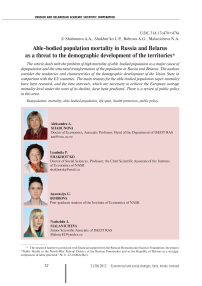Able-bodied population mortality in Russia and Belarus as a threat to the demographic development of the territories
Автор: Shabunova Alexandra Anatolyevna, Shakhotko Lyudmila Petrovna, Bobrova Anastasiya Grigoryevna, Malanicheva Nadezhda Antonovna
Журнал: Economic and Social Changes: Facts, Trends, Forecast @volnc-esc-en
Рубрика: Russian and Belarusian academic scientific cooperation
Статья в выпуске: 2 (20) т.5, 2012 года.
Бесплатный доступ
The article deals with the problem of high mortality of able-bodied population as a major cause of depopulation and the structural transformation of the population in Russia and Belarus. The authors consider the tendencies and characteristics of the demographic development of the Union State in comparison with the EU countries. The main reasons for the able-bodied population super-mortality have been revealed, and the time intervals, which are necessary to achieve the European average mortality level under the rates of its decline, have been predicted. There is a review of public policy in this area.
Depopulation, mortality, able-bodied population, life span, health protection, public policy
Короткий адрес: https://sciup.org/147223344
IDR: 147223344 | УДК: 314.17(470+476)
Текст научной статьи Able-bodied population mortality in Russia and Belarus as a threat to the demographic development of the territories
Source: European Health for All Database, WHO. Available at: ; World Development Indicators 2011.
The World Bank, 2011. Available at:
Source: European Health for All Database (January, 2012). Available at:
Insufficient substitutability of retirees with young people is a reason for the decline in the number of able-bodied population. There will be a rise of the problems related to a lack of labour resources and an increase in the economic burden on the able-bodied population from the older age groups both in Russia and Belarus in the coming years. Manpower shortage, which is not so noticeable during the economic crises, will require the compensation by increasing the productivity of the employed able-bodied population in future.
The contradiction between the rise in the demand for labour and the decline in its supply will be exacerbated by the growth of middleaged employees, as well as by the decrease of labour potential quality (due to the deterioration of health). There will be the need for higher health care costs, social services and pension provision due to the process of population aging in the medium term.
The main factor that has a negative impact on the demographic situation is the supermortality of able-bodied population. According to L.L. Rybakovsky’s assessement, a supermortality rate in Russia has amounted to about 3 – 3.5 million people over the period from 1991 to 2000 [9].
The dynamics of the standardized mortality rates, which negate the structure factor, shows the existence of supermortality in Russia and in Belarus (fig. 2) .
Figure 2. The dynamics of the standardized mortality rate for the total population and for the group aged 0 – 64 in Russia, Belarus and the EU countries, the number of cases per 100 thousand people
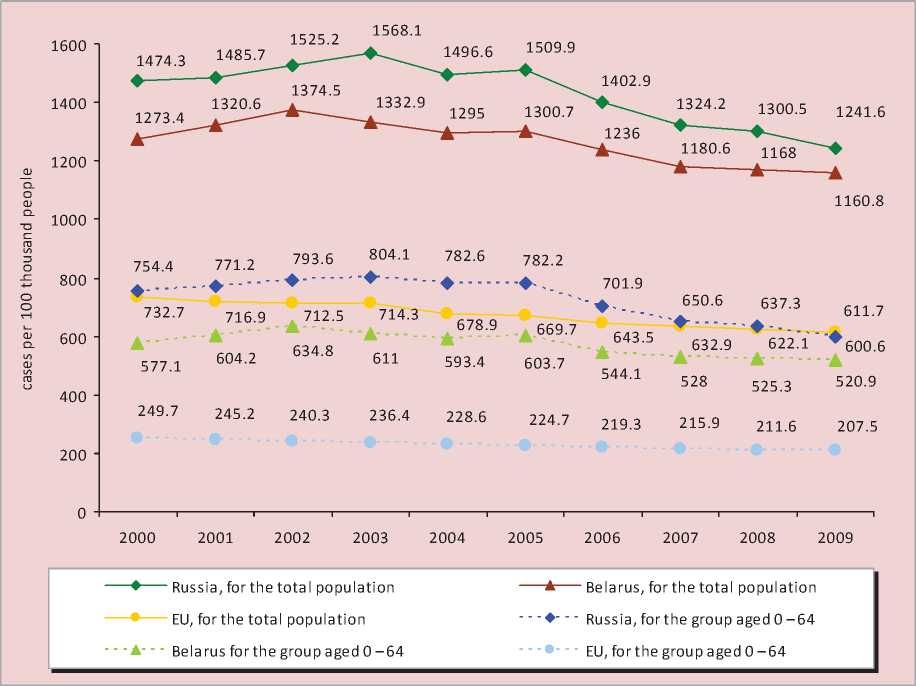
Source: European Health for All Database (January, 2012). Available at:
The dynamics of population mortality over the last decade (the period from 2000 to 2009) shows its small decline both in Russia and Belarus (by 19% and 10%, respectively). Steady downward trend in the mortality rates in these countries have been observed since 2005. The average rate of decline in mortality has amounted to 5% in Russia and 3% in Belarus over the last four years. Nevertheless, the mortality rate in the Union State is two times higher as compared with the European Union.
The gap of the mortality rates for the group aged 0 – 64 between Russia, Belarus and European countries is more than the gap of the standardized mortality rates for the total population. According to the data of 2009, able-bodied people died three times more often in Russia as compared with the European countries. Downward rates of mortality in this age group amounted to 6% in Russia and 4% in Belarus during the period from 2005 to 2009.
According to the World Health Organization, in 2009 the able-bodied population mortality rate per one thousand people amounted to 58 persons in Switzerland, 59 persons in Italy, 61 persons in Sweden, 67 persons in Norway, 68 persons in Spain, 76 persons in in Germany, Austria and Greece, 85 persons in France, 101 persons in the Czech Republic, 221 persons in Belarus, 269 persons in Russia and 274 persons in the Ukraine [16].
The able-bodied population supermortality in Russia is confirmed by the analysis of the growth rates of mortality age coefficients over two decades (fig. 3) .
There was the highest increase of the ablebodied population mortality in 2008 as compared with 1990. The maximum increase in mortality of both men (1.5 – 1.7-fold) and women (1.7 – 1.8-fold) was in the group aged 25 – 39. The child and juvenile mortality rates declined significantly.
Figure 3. Growth rates of mortality age coefficients of the population in Russia in 2008 as compared with 1990 (1990 = 1)
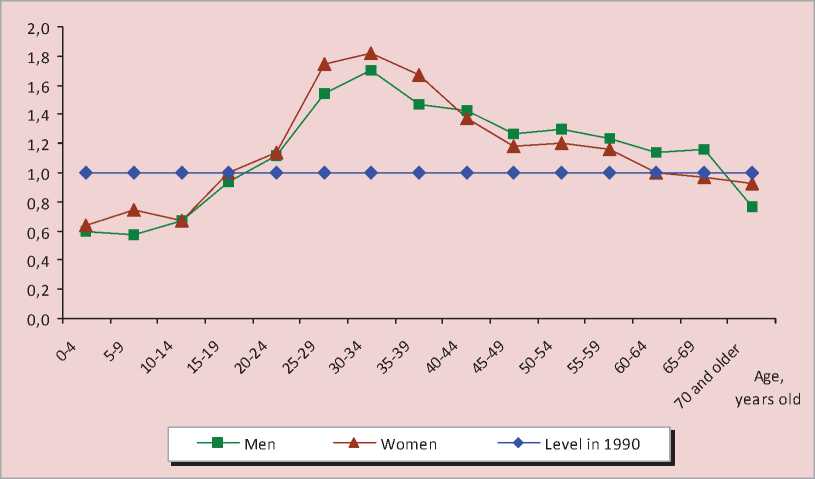
Source: Federal State Statistics Service. Available at:
The extremely high mortality rate is a reason for low life expectancy (LE) both in Russia and Belarus, where this rate, despite a slight increase, is lower, than in the Western European countries.
Life expectancy at birth is 79 – 81 years (men – 76-78 years, women – 82-85 years) in the developed countries. Life expectancy at birth is 61 – 65 years (men – 55-60 years, women – 66-75 years) in the developing countries. In 2009 life expectancy was 69 years in Russia and 71 years in Belarus. These figures are 10-11 years lower than in the EU countries (tab. 3). The male life expectancy remains extremely low. In 2009 the gender gap in the population life expectancy was 12 years in Russia, 11 years in Belarus, whereas it was 6 years in the EU.
Russia lagged behind the life expectancy rate of Western Europe in, adjusted with a glance to impairments, for 13 years and it is behind the life expectancy rate of Belarus for 11 years (as of 2007 healthy life span years was 60 years in Russia, 62 years in Belarus and 73 years in EU).
Because of premature mortality the population is losing about 11 years of potential life in Russia and 9 years in Belarus, whereas the population of the EU is losing only 5 years (according to data of 2009) (tab. 4) .
At the same time the decline in the male life span is twice as high as the female life span both in Russia and Belarus. It should be noted that there is a gradual reduction of premature mortality losses in the European countries, while there is no unambiguous downward trend in Russia and Belarus.
The mortality structure shows the knowledge about the main threats to premature mortality. Millions of people died over the centuries because of infectious disease epidemics. The progress in medical science allowed people to cope with them. In the XXI century, the predominant causes of death are chronic diseases, especially cardiovascular diseases, cancer, chronic lung diseases, diabetes, which are typical for most elderly persons and which have endogenous and quasi-endogenous determination [2].
Table 3. Life expectancy at birth in Russia, Belarus and the EU countries, years
Territory 1990 1995 2000 2005 2008 2009 Russia 69 64 65 65 68 69 men 64 58 59 59 62 63 women 74 72 72 72 74 75 Belarus 71 69 69 69 71 71 men 66 63 63 63 65 65 women 76 74 75 75 77 76 EU 75 76 78 79 79 80 men 72 73 74 76 76 77 women 79 80 81 82 82 83 Source: European Health for All Database (January, 2012). Available at:
Table 4. Reduction in life expectancy down to 65 years old due to untimely mortality, years
Territory 1990 1995 2000 2005 2008 2009 Russia 10.4 13.9 13.2 13.3 11.4 10.9 men 13.3 17.7 16.9 17.0 14.8 14.1 women 6.5 8.4 7.8 8.0 6.9 6.7 Belarus 9.0 10.8 10.2 10.3 9.2 9.2 men 11.7 13.9 13.3 13.4 12.0 12.0 women 5.7 6.5 6.1 5.9 5.2 5.3 EU 6.3 5.9 5.3 4.8 4.6 4.5 men 7.7 7.3 6.5 5.9 5.7 5.6 women 4.4 4.1 3.7 3.4 3.2 3.2 Source: European Health for All Database (January, 2012). Available at:
As of 2009 the mortality caused by such leading factors as cardiovascular diseases, cancer and external reasons was two or three times lower in the developed European countries than in Russia. Despite the decline in the share of infectious diseases in total mortality, their rate is higher in Russia than the average rate in the European Union and Belarus (table 5).
The share of cardiovascular diseases in the total mortality reasons is over 50% in Russia and Belarus and 37% in the European Union. The high mortality caused by blood circulation diseases is one of the main components of the Russian mortality crisis, which influences negatively over the trend of natural population growth. There is the most unfavorable situation in the population cohort of able-bodied men. The average age of men in Russia, died because of cardiovascular diseases, has decreased by more than 2 years over the last 15 years. Poor health of able-bodied population threatens the stability of the social and economic development of the whole country and its regions [12].
Malignant neoplasms are the second leading cause of mortality in Russia and Belarus. Their share is 14 – 15% in these countries and 28% in the European Union.
The rate of mortality caused by the external reasons (injury and poisoning) is too high. It intensifies demographic problems in terms of depopulation and population aging, although the external causes can be controlled by people at most.
Nevertheless, today they occupy the third place in the total structure of population mortality not only in Belarus and Russia, but also in Europe. In 2009 this factor amounted to 12% in the structure of mortality in Russia and Belarus and only 6% in the European Union.
At the same time, it should be noted that, as a rule, the external causes provoke ablebodied population mortality. The main causes of elder persons’ mortality (people aged over 65) are blood circulation diseases (fig. 4) .
For example, in Russia and Belarus 95 – 96% of the able-bodied people deaths are caused by injuries and poisonings and 31 – 32% of deaths are caused by blood circulation diseases.
Men remain the main group of people who have a high risk to die because of poisoning and injuries. Although the rate of their mortality, caused by those factors, has decreased in both countries over the last decade, it is four or five times higher than the level of the EU countries (fig. 5) .
The low level of self-preservation activity, unhealthy lifestyles and poor working conditions have a significant influence over the development of supermortality in Russia and Belarus.
Thus, there is a serious problem of supermortality among the able-bodied population in Russia and Belarus. It is largely responsible for the continuous decline in the population size, unfavorable transformation of age structure and potential socio-economic difficulties.
Table 5. Standardized mortality rate for the groups of mortality causes in some countries, in 2009 (per 100 thousand people)
Country Blood circulation diseases Malignant neoplasms Injury and poisoning Infectious and parasitic diseases Russia 683.0 182.1 147.2 22.5 Belarus 601.1 162.8 133.6 11.5 Finland 218.1 134.8 63.8 4.9 Germany 217.2 159.9 27.9 10.4 EU 227.6 170.5 37.1 8.8 Source: European Health for All Database (January, 2012). Available at:
Figure 4. The death share among the people aged from 0 to 64 by three groups of causes, 2009, in% (calculated according to standardized mortality coefficients)
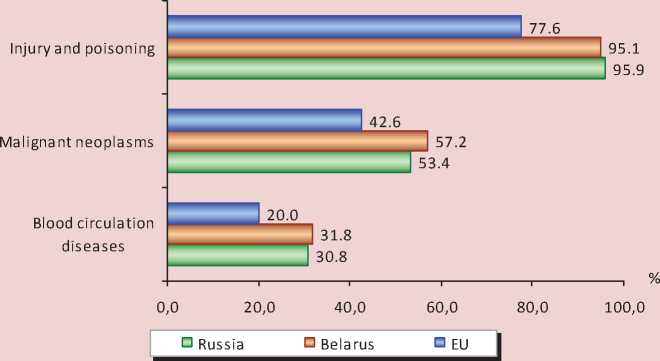
Source: European Health for All Database (January, 2012). Available at:
Figure 5. The dynamics of the standardized mortality rate caused by poisonings and injuries, 2000 - 2009, cases per 100 thousand people
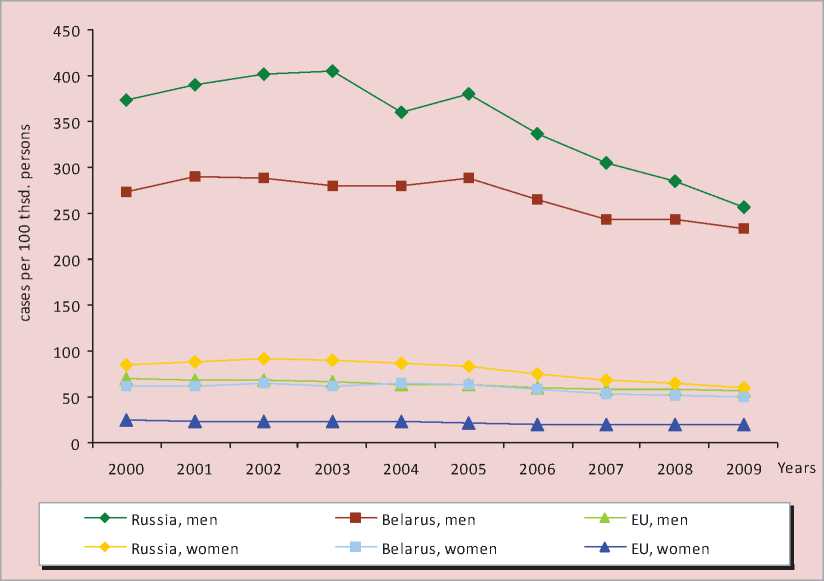
Source: European Health for All Database (January, 2012). Available at:
Our calculations show that if the drawdown rate of population mortality, which formed over the period from 2005 to 2011, remains, the mortality rate in Russia will have reached the European average level by 2023, while Belarus will have reached it only by 2030. The mortality rate for the group aged under 64 will be closer to the average European rate in 2026 in Russia and in 2031 in Belarus. Under such conditions, when the load on the able-bodied population increase, it will be necessary to focus the efforts, aimed at the rapid solution of this problem, because it affects the national security interests of these states.
The high mortality of able-bodied population is one of the main challenges of modern health care system in Russia and Belarus. At the same time, the most important and underused reserves are associated with the reduced morbidity and mortality of active able-bodied people. However, there is a lack of attention to those components of the health care system that are the essential part of the most pressing problem. In fact, the Russian health care system, based on the strong priority of treatment rather than prevention, prioritizes the interests of the people, who are under or over able-bodied age [11].
The Conception of Demographic Policy in the Russian Federation for the period until 2025 deals with the problem of able-bodied population supermortality. It stresses the male supermortality [4]. The reduction of population mortality, particularly a high mortality rate among able-bodied male population because of external causes, is designated as one of the priorities of the state population policy in the Conception of the Socio-Economic Development of the Russian Federation until 2020 [5]. The Federal Law “On the basis of health protection in the Russian Federation”, which reflects the basic principles of health, rights and duties of citizens in the field of health care and other issues, has come into force since November 22, 2011 [14].
The Government of the Republic of Belarus also stresses the problems of public health. The National Programme of Demographic Security of the Republic of Belarus for 2011 – 2015 has been developed, and it is being realized now [6]. Some measures are being implemented within the scope of this programme in order to promote public health and increase life expectancy. In addition, there is a range of targets programs aimed at the public health promotion. However, the current documents don’t produce any targets or mechanisms to achieve them. The lack of specific guidelines and methods to assess the effectiveness of program activities reduces their value. Under these circumstances it is not enough to understand the situation, it is necessary to improve it purposefully and regularly.
Today experts see two possibilities: the significant increase in health care financing or the development of health protection system with a minimum necessary increase in funding.
Russia lags far behind the Western European countries in terms of health care financing. The share of total health care expenditure in the GDP of Russia is 1.7-fold lower than in the EU (5.2% versus 9% in 2008), and the share of governmental health care expenditure is 2-fold lower (3.4% vs. 6.9% in 2008). In absolute terms, health care expenditure per person is 3.9-fold lower in Russia than the average health expenditure in the EU countries (567 and 2203 dollars respectively according to purchasing power parity, 2008). Though, there are significant achievements in the improvement of health care financing in the Russian Federation in recent years. However, most likely it won’t be possible to increase public health funding up to the level comparable with the current levels of the European countries by 2020 due to the lower rates of economic growth as compared with the period from 2000 to 2008. Therefore, the mortality gap between Russia and the European countries will not be overcome.
According to the second scenario, it is necessary to prioritize the promotion of healthy lifestyle, environmental issues, disease prevention and the improvement of efficiency and quality of medical institutions. Today the dealing with the measures of healthy lifestyle promotion isn’t adequate to their role in the reduction of morbidity and mortality in comparison with medical aid. The current arrangements are too conservative and inadequate in terms of content and funding. Nowadays, some policy documents have been approved in Russia, health centers are being built, excise rates on alcohol and tobacco have been increased a little bit, but these measures aren’t enough. Every effort should be focused on the development of preventive areas, so it will be possible to increase health care funding, develop the potential of the active part of society and reduce the loss of able-bodied population.
The country’s leadership understands the importance of social responsibility and prioritizes the human potential preservation. Vladimir V. Putin pointed out in his article “Building justice: A social policy for Russia” that: “Should we fail to carry out a large-scale and long-term project for demographic development, the buildup of human resources and territorial development, we risk becoming an “empty space” in global terms, and then our fate will be determined by someone else, not us”.
If we keep things unchanged and fail to come up with any new measures, Russia’s population will shrink to 107 million by 2050. Conversely, if we manage to formulate and implement an effective and comprehensive population conservation strategy, Russia’s population will grow to 154 million. Therefore, the historical price of the choice between action and inaction is almost 50 million human lives within the next 40 years. Putin stressed that life expectancy has increased by three years in Russia over the last five years and the pace of progress cannot be reduced [8].
Significant funds are invested in health care recently (within the national project “Health” and the programme “Health Care Modernization”). At the same time, our personal responsibility for our health should be increased. Today 80% of people in Russia do not exercise while 65% drink or smoke regularly and 60% have medical check-ups only if they are ill. Under these circumstances, when the health indicators remain low and most citizens don’t realize the value of health, it is necessary to promote their need for self-preservation behavior and health care.
Thus, there are national programmes in both countries developed to promote public health and reduce mortality. However, it should be noted that there is no common programme in the Union State aimed to preserve and increase the population in Russia and Belarus.
Список литературы Able-bodied population mortality in Russia and Belarus as a threat to the demographic development of the territories
- elarus Census Database. Available at: http://belstat.gov.by/homep/ru/perepic/2009/database.php
- Demographic Modernization in Russia, 1900 -2000. Ed. by A.G. Vishnevsky. Moscow: New Publishing House, 2006.
- European Health for All Database (January, 2012). Available at: http://data.euro.who.int/hfadb/shell_ru.html
- Conception of Long-term Demographic Policy in the Russian Federation for the period until 2025. Approved by the Decree of the President of the Russian Federation as of October 9, 2007, No. 1351. Collected Legislation of the Russian Federation. 2007. No. 47. Art. 5009.
- Conception of the Socio-Economic Development of the Russian Federation until 2020. Approved by the Order of the Government of the Russian Federation as of November 17, 2008, No. 1662-p. Collected Legislation of the Russian Federation. 2008. No. 47. Art. 5489.
- National Programme of Demographic Security of the Republic of Belarus for 2007-2010. Available at: http://www.mintrud.gov.by/ru/min_progs/prog22.
- The final results of the National Population Census 2010. Available at: http://www.perepis-2010.ru/results_of_the_census/results-inform.php
- Putin V.V. Building justice: A social policy for Russia. Russian Newspaper. 2012. No. 5703.
- Rybakovsky L.L. Applied demography (2001 -2003). Moscow: ISPR RAS, 2003.
- The world health report 2008: now more than ever. WHO, 2008.
- Strategy -2020: New model of growth -new social policy: final report on the results of expert research of the actual problems of the socio-economic strategy of Russia till 2020. Available at: http://2020strategy.ru/data/2012/03/14/1214585998/1itog.pdf
- Trubacheva I.A., Perminova O.A., Karpov R.S. Mortality in the population cohort of able-bodied men. Health Care in the Russian Federation. 2009. No. 5. P. 34-35.
- Federal State Statistics Service. Available at: www.gks.ru
- On the Basis of Health Protection in the Russian Federation. Federal Law as of 21.11.2011, No. 323 -FZ. Russian Newspaper. 2011. No. 263.
- World Development Indicators 2011. The World Bank, 2011. Available at: http://data.worldbank.org/data-catalog/world-development-indicators.
- World Health Statistics 2011. The World Health Organization, 2011. Available at: http://www.who.int/whosis/whostat/EN_WHS2011_Full.pdf

